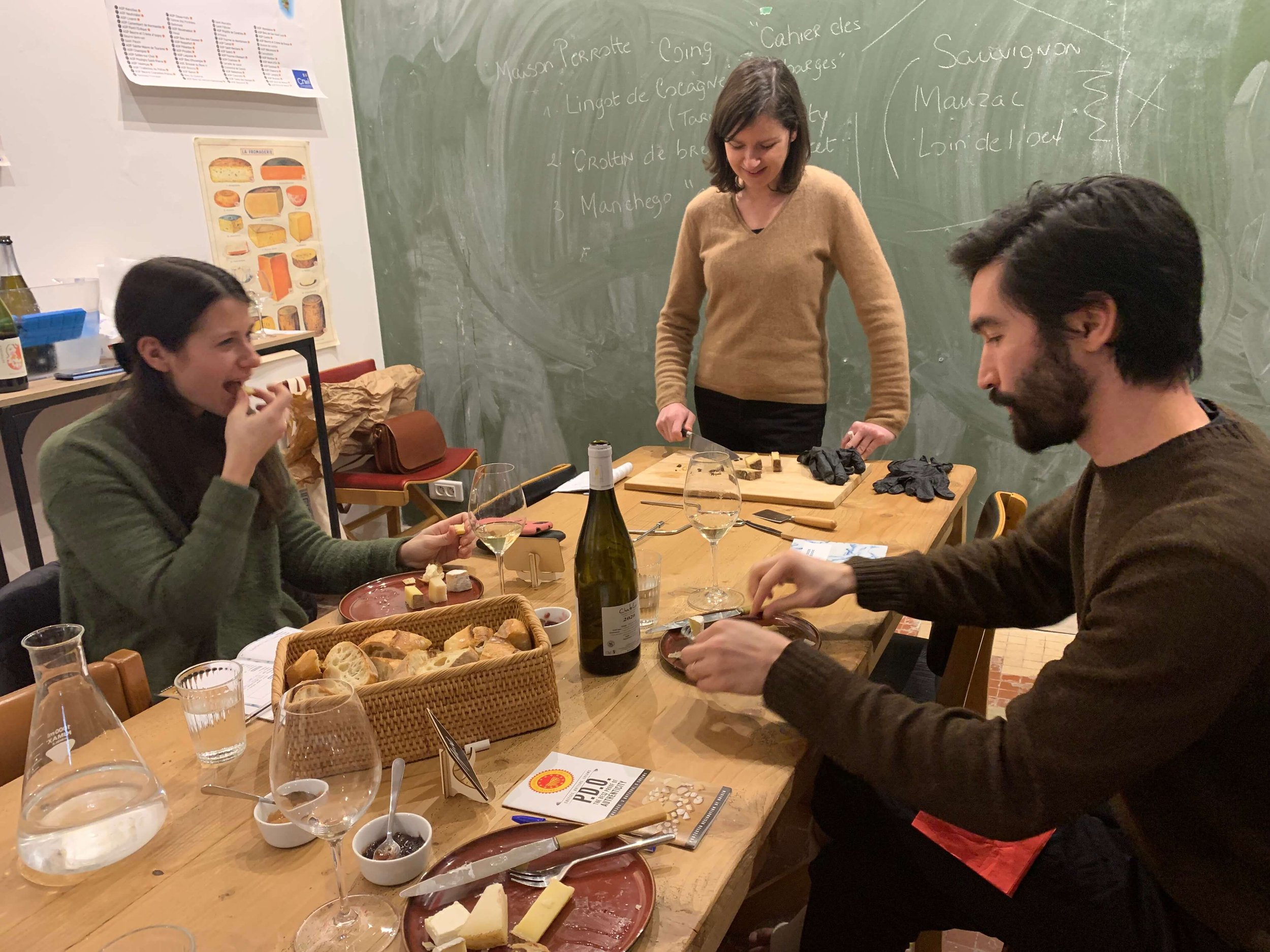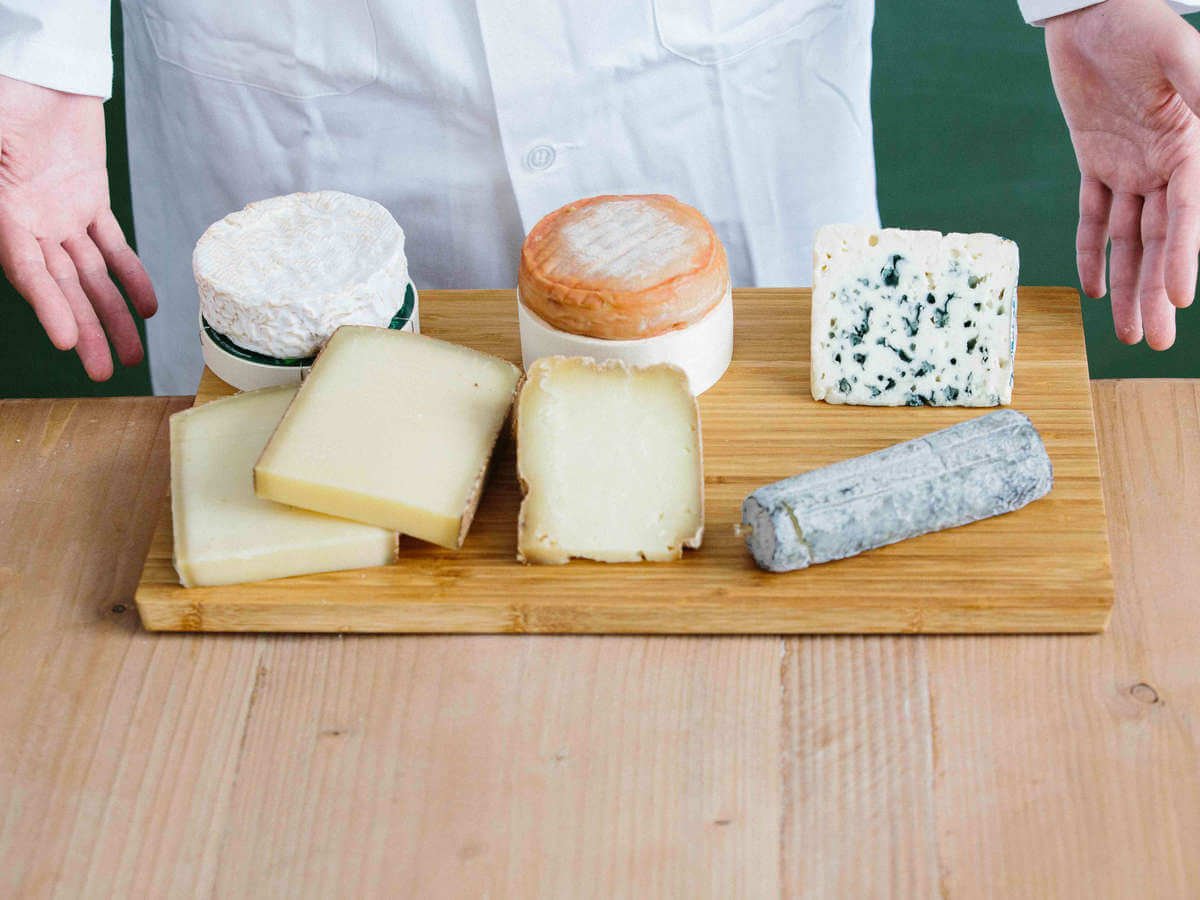The Best Way to Geek Out on Cheese in Paris
Suppose you are a cheese lover and find yourself in Paris feeling a bit intimidated to march into a fine fromagerie, its shelves filled with creamy rounds of Reblochon, Rocamadour, and Rigotte de Condrieu, and confidently order a selection of cheeses.
Cheese Geek class photo credit Anna Mindess
In just two hours, you can become an official “Cheese Geek” with a certificate and geeky eyeglasses to prove it. In a cozy tasting room, Le Cheese Geek offers playful and educational tasting workshops that will introduce you to a half-dozen cheeses from across Europe, and pair them with a selection of bread, jams, and, of course, wines, (or non-alcoholic beverages). You will practice using all your senses in cheese tasting. The session booklet includes a wheel of aromas, an outline of the cheese-making process, a description of the eight types of cheese, and discusses the art of pairing. There may be informal quizzes and blindfolded cheese tastings, but with at least three glasses of wine, it is all in good fun. You will learn about the seasonality of cheeses, (depending on what the cows are eating) and why a dry white wine like Chablis is a “passe-partout” or a good pick to go with a variety of cheeses. The class is not so much about rules, rather it gives you the power to decide what you like.
Le Cheese Geek photo credit Thomas Bresteau
Le Cheese Geek
Fabrice Gepner started Le Cheese Geek in 2017, after a detour from a serious business career. During a summer break spent WWOOFING, he worked on several organic farms in France, including a dairy farm, where he says, “Walking the goats, I realized that this great experience was a real authentic moment of happiness in my life.” After two more years in advertising, he remembered “feeling so happy on the farm, so connected with the animals and people,” that he decided to explore a new avenue.
After attending a training course in Paris to become a crémier-fromager, he set up classes in both French and English. “I realized my end goal was not to feed people cheese, “says Gepner. “I could have opened a cheese shop or a cheese restaurant for that. What I really wanted was the opportunity to discuss societal and environmental issues through workshops, friendly games, and blind tastings.”
While he offered classes in both French and English, Gepner admits he “preferred leading the English classes, which had mostly Americans, since they were more genuinely interested and knowledgeable than my French audience.”
“French people think they know everything about cheese.” he says. “They have such a blasé attitude and respond to each cheese selection with “c’est pas mal,” (literally “not bad”) compared to Americans who get excited, and say something like, ‘That’s amazing!’ Especially with a group of 8-10 people, who might not know each other, the atmosphere is much more friendly and fun with the Americans, compared to the Parisians. The tourists are genuinely interested in learning specific details regarding cheesemaking and the cheese industry.”
While Gepner was the only host at the outset, now he has added several other trained geeks and geekettes who lead the two-hour classes.
Virtual Classes
With the pandemic, of course, the in-person classes took a big pause (but they recently restarted). During the imposed break, Gepner pivoted to remote classes, focusing on team building (or “food building” as he calls it) for companies, in which he sends out kits with cheeses, wines, and chocolates and conducts tastings peppered with quizzes and other games. This company, called Questions pour une Fine Bouche, will also send tasting kits across Europe, to Japan and the U.S. The bigger events are intended for groups of 10 -500 participants.
Handouts at Le Cheese Geek class photo credit Anna Mindess
A Raw Milk Advocate
One of Gepner’s motivations behind all his classes is to sensitize people to environmental and animal issues. He discusses raw milk vs pasteurized milk, industrial milk vs farmstead milk. “My goal is to make people realize what they’re eating and that the act of eating cheese actually has an impact on the environment and the well-being of animals.”
He explains that “pasteurized” means the milk must be heated to 72 degrees Celsius (161 Fahrenheit) for 15 seconds to kill the bacteria. “It doesn’t affect the animal, “he says, “but it’s a method used in the industry so that they don’t have to be so concerned about having good milk in the first place. This allows big companies and factories to industrialize the process of cheesemaking, because when you kill the milk in this way, you can use machines to make, for example, 100,000 camembert a day.”
Clearly, Gepner feels strongly about this. “When you kill all the bacteria in the milk, it means you can have dirty milk in the first place,” he says. “When animals are badly treated, specifically by being fed non-nutritious food that is focused on making them super-productive, they will only last a year or two. Then you kill their stomachs and kill them, and they will be steaks after two years.” He adds, “The dairy industry, like other huge food industries, has a very dark side.”
“If you use raw milk, however,” he continues, “it’s full of bacteria and germs, flora that makes it alive. You can’t industrialize it on such a huge scale. You must have men and women watch how the milk is evolving, how the curd is evolving. In a way, it allows you to maintain the link between the milk, the cheese, and the human with their savoir-faire. If you are working with raw milk, it means you must give your animals good nutrition, and that they go outside and eat fresh grass.”
Cheese Pairing
When it comes to pairings, Gepner and the other Cheese Geek instructors emphasize that pairings are up to you. “We have so many rules in life,” he says. “My goal in these workshops is to teach people to become confident with their own tastes. The point is really to enjoy the experience. On the subject of pairing cheeses with beverages, Gepner says he shares tips, not rules. “Suppose you have a cheese plate and have to choose just one bottle of wine, there is a better chance to make a match if you choose a white wine, instead of a red. My rule is to follow your instinct. But if red wine brings you good feelings and good memories, then go for it.”



